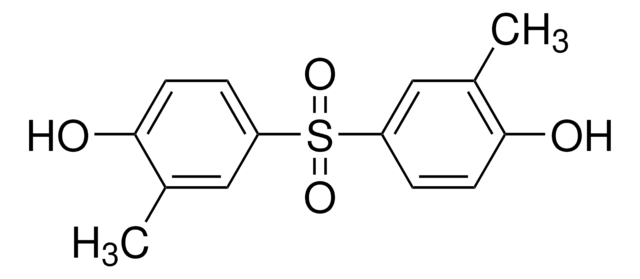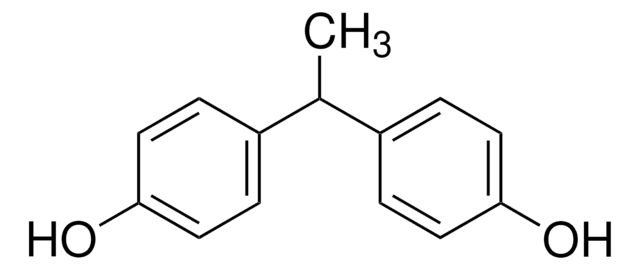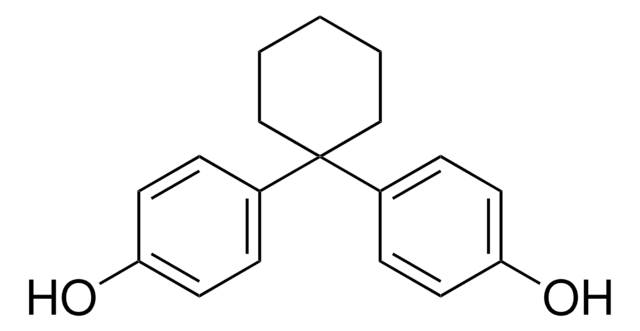If this product has an expiration or retest date, it will be shown on the Certificate of Analysis (COA, CofA). If there is no retest or expiration date listed on the product's COA, we do not have suitable stability data to determine a shelf life. For these products, the only date on the COA will be the release date; a retest, expiration, or use-by-date will not be displayed.
For all products, we recommend handling per defined conditions as printed in our product literature and website product descriptions. We recommend that products should be routinely inspected by customers to ensure they perform as expected.
For products without retest or expiration dates, our standard warranty of 1 year from the date of shipment is applicable.
For more information, please refer to the Product Dating Information document: https://www.sigmaaldrich.com/deepweb/assets/sigmaaldrich/marketing/global/documents/449/386/product-dating-information-mk.pdf
103039
4,4′-Sulfonyldiphenol
98%
Synonym(s):
4-Hydroxyphenyl sulfone, Bis(4-hydroxyphenyl) sulfone, Bisphenol S
Select a Size
Select a Size
About This Item
Recommended Products
Assay
98%
form
solid
mp
245-250 °C (lit.)
SMILES string
Oc1ccc(cc1)S(=O)(=O)c2ccc(O)cc2
InChI
1S/C12H10O4S/c13-9-1-5-11(6-2-9)17(15,16)12-7-3-10(14)4-8-12/h1-8,13-14H
InChI key
VPWNQTHUCYMVMZ-UHFFFAOYSA-N
Looking for similar products? Visit Product Comparison Guide
Related Categories
General description
Application
- As a monomer to synthesize fibrous poly(arylene ether ketone)s with excellent water affinity, thermal stability and film forming capability. This can be utilized to fabricate Proton exchange membranes for electrodialysis, fuel cells and flow batteries.
- As a precursor to prepare polyphosphazene-based contrast agents for magnetic resonance imaging (MRI) and computed tomography (CT). It enhances the thermal stability, chemical resistance and allows easy functionalization of contrast agents.
- As a monomer to prepare poly (cyclotriphosphazene-co-4,4-sulfonyldiphenol) (PZS) coating for separators, in lithium-ion battery. The coated separators show sufficient enhancement of liquid electrolyte wettability and ionic conductivity, resulting in better cycle performance.
Signal Word
Danger
Hazard Statements
Precautionary Statements
Hazard Classifications
Repr. 1B
Storage Class Code
6.1C - Combustible acute toxic Cat.3 / toxic compounds or compounds which causing chronic effects
WGK
WGK 1
Flash Point(F)
Not applicable
Flash Point(C)
Not applicable
Personal Protective Equipment
Regulatory Listings
Regulatory Listings are mainly provided for chemical products. Only limited information can be provided here for non-chemical products. No entry means none of the components are listed. It is the user’s obligation to ensure the safe and legal use of the product.
EU REACH SVHC Candidate List
EU REACH Annex XVII (Restriction List)
Choose from one of the most recent versions:
Already Own This Product?
Find documentation for the products that you have recently purchased in the Document Library.
Customers Also Viewed
-
How can I determine the shelf life / expiration / retest date of this product?
1 answer-
Helpful?
-
-
How is shipping temperature determined? And how is it related to the product storage temperature?
1 answer-
Products may be shipped at a different temperature than the recommended long-term storage temperature. If the product quality is sensitive to short-term exposure to conditions other than the recommended long-term storage, it will be shipped on wet or dry-ice. If the product quality is NOT affected by short-term exposure to conditions other than the recommended long-term storage, it will be shipped at ambient temperature. As shipping routes are configured for minimum transit times, shipping at ambient temperature helps control shipping costs for our customers. For more information, please refer to the Storage and Transport Conditions document: https://www.sigmaaldrich.com/deepweb/assets/sigmaaldrich/marketing/global/documents/316/622/storage-transport-conditions-mk.pdf
Helpful?
-
Active Filters
Our team of scientists has experience in all areas of research including Life Science, Material Science, Chemical Synthesis, Chromatography, Analytical and many others.
Contact Technical Service










